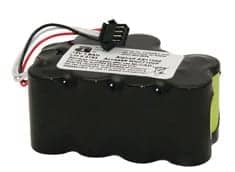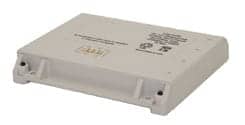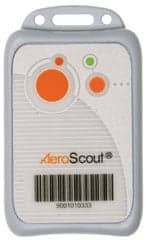One might think that Bill Dugan, CBET, has 1,675 reasons to worry about batteries. As the director of clinical engineering services of the 300-bed St Vincent Healthcare in Billings, Mont, Dugan is responsible for 1,675 medical devices that utilize some type of battery, from lead acids to lithium ions and the occasional “smart” battery.
But Dugan and other veteran biomedical equipment technicians say that there is no magic bullet to preventing battery failures or reducing battery costs. They simply advise a common-sense approach to regular preventive maintenance and to reducing costs through regular battery testing and cautious utilization of trusted third-party battery vendors.
From Crash Carts to Infusion Pumps
While St Vincent may not be a huge urban medical center, it is not surprising that Dugan has to maintain and keep track of its thousand-plus devices—part of a total of 5,500 devices under his watch—that require some type of battery.
As manufacturers improve the design of their products to make them safe from power outages, more portable, and ready for emergencies, batteries play a more important role in medical devices.
Wall defibrillators, portable automatic blood pressure cuffs, and uninterruptible power supply (UPS) units are just a few of the devices biomeds must maintain with an assortment of proprietary and off-the-shelf batteries. While devices may not be equally critical, clinicians and staff still expect them to work—regardless of function. Consequently, a biomed’s choices of supplier and battery type, and the battery’s maintenance schedule, are not only economic decisions, they can actually become life-and-death decisions in the case of a rarely used emergency defibrillator on the wall that has lost its charge.
“Every device has some level of criticality,” says David Marlow, CET, CBET, senior biomedical technician at the University of Michigan Health Systems, Ann Arbor, Mich. “There’s a lot of things to consider in every decision. We don’t have a set rule for how we’re going to decide. The technicians that are maintaining each set of equipment work out with management what they want to do and how they’re going to do it.”
In general, biomeds can expect to see four main types of rechargeable batteries throughout the medical center, plus the various “smart” versions of these batteries—those that have the ability to provide information. The battery types include:
- Lead-acid;
- Nickel-cadmium (NiCd);
- Nickel-metal-hydride (NiMH); and
- Lithium-ion (Li-ion).
Safer, Smarter Batteries
Many batteries in medical equipment, especially Li-ions, are now embedded with micro computer chips that can not only display the remaining charge, but also will monitor temperature, current, and potential short circuits. They can also prevent overcharging the battery pack. In addition, these systems typically shut the battery off in case of any malfunction.
Smart batteries may have their own internal self-maintenance and alert systems that tell users when the battery is failing or that it needs recharging. However, that does not mean that an engineer can forget about them.
Charles R. Hurtt, CBET, supervisor of biomedical services, Viera Outpatient Veteran’s Clinic, Viera, Fla—a satellite of the Orlando Veterans Hospital, Orlando, Fla—says, “Most of the smart batteries have a way to do your own self test to make sure they’re all right. To their credit, I’ve had none do me wrong. I’ve had batteries that I swore would have been good that the self test didn’t like, and sure enough, they weren’t right. They’d shorted or had a bad cell. So I’ve had reliable enough information, but I’m old school, and I like to test them myself.”
Marlow has also seen problems with his smart batteries. “Sometimes I’ve seen more problems with the smarts than the batteries,” he says. Marlow sometimes places an original manufacturer’s smart battery in a defibrillator and the smart charger will say, “discard.” He says, “For various parameters that are inside the chip in the battery, it’s telling it that it’s no good, but I’ll do a test on that battery pack and it tests just fine.”
Marlow cautions that just because his tests indicate the battery is fine, he will never put a rejected battery back into the device. He adds that it is frustrating to him not knowing what the real problem is. If a battery is rejected or fails within its warranty, it should be exchanged under warranty.
OEM or Third Party?
Perhaps the most important management decision a biomed can make about batteries is the choice of whether to go with a device’s original equipment manufacturer (OEM) or purchase spares from a third-party provider.
William A. Luberger, biomedical engineering supervisor at Veterans Administration Medical Center, Beckley, WVa, says that third parties provide his facility tremendous cost savings on everything from defibrillator batteries to infusion pumps. “We only use OEM batteries when no good substitute is available, such as with most smart batteries that have a chip implanted in the pack,” he says.
While third-party batteries may bring significant savings, Marlow cautions that one must still verify and test the performance. “You can save quite a bit of money by buying from a third-party supplier rather than buying from the manufacturer, provided you have the knowledge of those batteries and know how to test them. If you just want to play dumb and sit back and say, ‘Well, I just change them when the manufacturer tells me, and I use the batteries from the manufacturer,’ that system works. You’ve got an excuse if it fails, but I’ve seen bad batteries come from the device manufacturers, even for artificial heart devices.”
Marlow strongly urges clinical/biomedical engineering departments to verify the performance of any battery, whether third party or OEM, but especially third-party batteries. “Once you buy third-party batteries from a vendor that has not received specific FDA approval, it’s like you’re now making yourself a battery manufacturer,” he says. “You are now certifying the batteries. The company that you’re buying from may be giving you a warranty, but are they specifically certifying this application?”
The more life-support critical a device is, the more one takes a risk by utilizing a third-party battery. There are, of course, manufacturers that will use proprietary batteries that force institutions to buy their batteries.
While some may feel tempted to avoid buying a device that requires expensive proprietary batteries, Dugan says one cannot buy a piece of equipment based upon battery choices. “I’m buying that piece of equipment based upon multiple things, the first being manufacturer confidence, and then based on support issues,” he says. “There are some batteries that are proprietary, and when you run into those, yes, you will have to buy from that manufacturer. I don’t like that, but if it’s the equipment of choice, and it’s the best for the clinical needs, then I’ll buy it.”
Finding a Third-Party Supplier
Finding a reliable supplier is a matter of networking and one’s own verification. “You want to pick a good aftermarket manufacturer, but you verify; you need to test them,” Dugan says. “You do a random sampling of the batteries and make sure that they are in fact equal to the original manufacturer’s. If you’ve done that legwork, then you’re fine.”
Hurtt has particularly found online biomed communities useful for finding a third-party supplier. “When I go with third-party suppliers, I go with ones that have proven themselves to offer good batteries, good components, good wires, or good transducers. I find that out by communicating with other biomeds online. You ask, ‘Have you been using these batteries? Have they been good for you?’ You’ll get a million responses.”
Dugan has used the Biomedtalk Listserv to not only research suppliers, but also to troubleshoot battery issues for particular devices. If a device is burning through more batteries than expected, other users will give insights, helping him to determine if others are having the same issue with the particular third-party battery or if it is the energy usage of the device with any battery.
On Schedule Versus the Analyzer
Battery analyzers and their related testing software should be a part of any clinical/biomedical engineering department’s battery management, especially when purchasing batteries from third-party vendors.
For Dugan, the most important thing to look for in a battery analyzer is that it has consistent, reproducible results. “You want them to charge at a certain rate and discharge at a certain rate, and just plot voltage over time and monitor it and cut it off at a certain point. They’re really pretty basic,” he says.
The battery-replacement schedule will vary greatly with the device. Some state regulations will mandate that critical devices, such as defibrillators and life-support equipment, be changed every 2 years, while noncritical devices can simply follow replacement based on the manufacturer’s recommendations. However, that system may not be cost effective.
For non-life-support devices, an analyzer can help save money by verifying a better than 80% capacity for noncritical devices and 85% for life-supporting devices.
“A lot of manufacturers will just say if it runs for 20 minutes then the battery’s OK,” Marlow says. “Well, that’s not good enough, as it only shows that that battery is OK today for tests that you are performing on the device. It won’t assure you that the battery will last until the next inspection. In place of fully testing the battery, they want you to just replace the battery as recommended. In my experience, I’ve found that’s wasteful because their recommendations are usually (but not always) very conservative.”
Marlow adds, however, that if one’s analysis indicates that the battery may not last until its next scheduled test, then it is not worth keeping the battery in service and having it fail during use. He defines analysis as “looking at the battery for physical deformities, testing it on a battery analyzer, evaluating the test results including the charge and discharge, voltage and current curves for abnormalities, and in the light of the history of its type in the same application.”
Unless the manufacturer recommends shorter intervals, Marlow tests all of his critical batteries every 6 months. “We know that our 6-month policy is working here because we’re not seeing significant failures between tests,” he says. “We’re catching them before anyone notices problems in the use of them. That should be a good criterion if your testing system is working. Noncritical batteries may only be tested once a year or as a problem is suspected.”
Luberger also recommends that biomeds regularly test UPS devices. “In my experience, few are tested on a regular basis to see if they really are functional. We test them on the same schedule as the medical equipment that they are connected to. We routinely replace batteries after 3 years on a critical UPS.”
As for what to do with those batteries after their useful life or a failure, some hospitals have their own in-house environmental disposal programs. However, medical centers are now turning to hazardous waste or battery recycling companies that collect all types of batteries from the institution for recycling or proper disposal.
To Spare or Not to Spare
None of these biomeds had a particular system for keeping the right amount of spares on hand. If one orders too many, they may sit on a shelf losing capacity and wasting money. If one does not order enough, clinicians may be caught without the use of their device. With critical devices, one most always err on the side of having too many rather than too few.
Hurtt says that sparing just comes down to experience and equipment history. “It’s kind of a professional call. It’s like a stock level for light bulbs or anything else. You see what the demand for them is through equipment history, and you can talk to other biomeds and get a feel from people that owned them, if you haven’t owned them. The equipment history tells a lot.”
Marlow offers that sparing decisions may often be best left to the technicians who service a type of device and stock clerks who monitor the stock for the generic batteries that the device carries.
Dugan is even more conservative. “For non life-support systems, in order to keep batteries from aging on the shelf, I do rely just on shipping. I can get a battery here in 2 days,” he says.
Tor Valenza is a staff writer for 24×7. For more information, contact .
 |
| Versatile lead-acid batteries are used in EKG machines and defibrillators. |
 |
| NiCd batteries have flexible charging methods. |
 |
| NiMH batteries lose their capacity from frequent full discharges. |
 |
| Li-ion batteries are slowly being incorporated into portable medical devices. |
The Battery Lowdown
The main rechargable batteries clinical/biomedical engineers can expect to work with are listed below, along with details on how to get the most charge out of the battery.
Lead-acid: Usually sealed gel types, sealed lead-acid rechargeable batteries are the heavy lifters of the medical device world. Lead acids are versatile and can reside in everything from defibrillators to EKG machines to electric wheelchairs. Lead acids last longer with partial discharges and should be recharged soon after use rather than further discharged. Ideally, lead acids should be kept to an 80% depth of discharge and recharged with a constant voltage. Fast charging, or charging in 1 hour or less for a complete charge of a fully discharged battery, is not possible.
Nickel-cadmium (NiCd): NiCd batteries—once the rechargeable battery of choice for small, portable devices—are relatively light and known to be durable, withstanding many charges and discharges to around 1,000 cycles. NiCds have flexible charging methods, holding up well for trickle charges or fast-charging systems. While NiCds may appear to be ideal, due to environmental concerns about cadmium, a toxic element in its chemistry, manufacturers have offered NiMH as replacements.
Nickel-metal-hydride (NiMH): Often interchangeable with NiCd batteries but less durable, NiMH batteries lose their capacity from frequent full discharges. Aside from the environmental factor, the advantage of NiMH batteries over NiCd batteries is that they may run 50% longer under the same load. However, their overall life span is typically shorter, lasting perhaps 400 cycles compared to the 1,000 cycles of NiCds. NiMHs perform best by keeping current charging methods constant and by keeping their depth of discharge to 80%. Cells could be damaged if batteries are left in the charger and overcharged. New NiMH “smart” batteries and corresponding chargers will cut off the charge. Of course, these are more expensive.
Lithium-ion (Li-ion): Li-ion batteries are slowly being incorporated into many portable medical and communication devices. The chemistry performs well with devices that are used frequently for short periods of time, being discharged minimally and then recharged. Unlike NiMHs, overcharging is not normally a problem and batteries can be left in reserve plugged into an outside charger or charging in the device. Utilizing the battery until it is completely discharged will shorten the life span, so engineers should educate users about plugging devices in as soon as possible after portable use. Li-ions should be charged with constant voltage to typically 4.20 v/cell. Fast-charging methods are not possible. The downsides to Li-ions include a higher cost compared to other battery types, they have an extreme sensitivity to heat, and they need to be kept cool. Many Li-ions are now smart batteries that have internal temperature sensors and alarms. There have also been several recalls in the last few years, so one should be vigilant in battery analysis during preventive maintenance checks.
—TV
PHOTOS SUPPLIED BY ALPHA SOURCE INC





